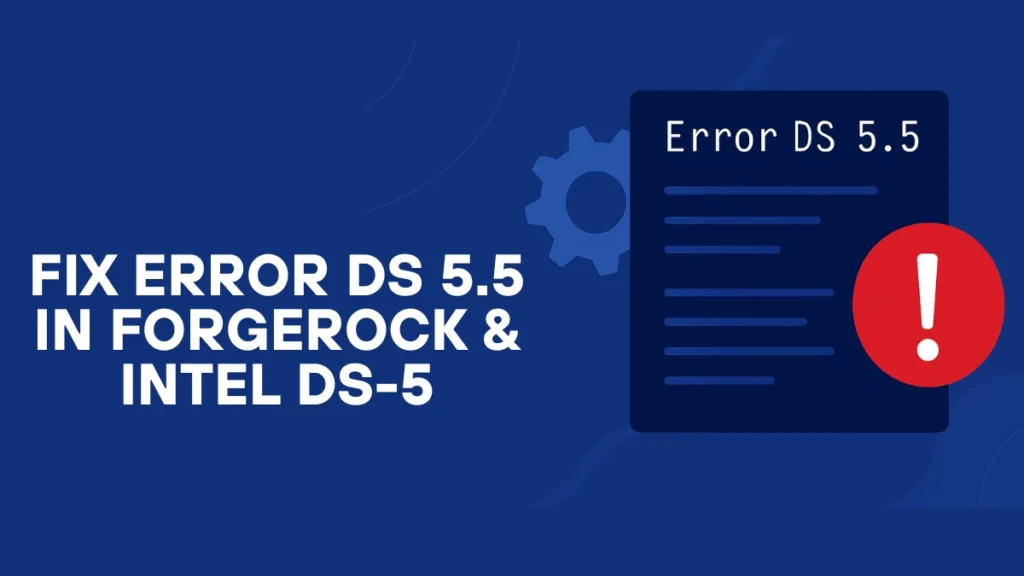Error DS 5.5 is a label that can surface in various software environments, particularly in enterprise tools like ForgeRock Directory Services and Intel’s DS-5 development suite. The error doesn’t represent a single problem type—instead, it’s a context-sensitive identifier that could mean very different things depending on where it appears.

ForgeRock Directory Services (DS) 5.5 Errors
ForgeRock DS 5.5 is an LDAP-compliant directory server used for access control, identity storage, and authentication services. When an error like DS 5.5 occurs, it often corresponds to a server-side error message with a unique ID and descriptive text. These logs are typically found in:
/path/to/opendj/logs/errors
/path/to/opendj/logs/replicationUnderstanding these logs is essential for diagnosing misconfigurations, broken dependencies, or access control issues.
Common Error Categories and Fixes
Let’s break down the typical categories and how to resolve them. Error ID references are taken directly from ForgeRock’s log definitions.
Access Control Errors (IDs: 104, 105, 107, 108)
These errors are triggered when directory policies reference invalid or malformed DN (Distinguished Name) patterns or unsupported control aliases.
Examples:
ID 104: The global access control policy could not be parsed due to an invalid target DN pattern.ID 107: Use of an unrecognized control alias.
Fix:
- Review the access control configuration files (
config.ldif) for malformed DN entries. - Use valid control aliases as per ForgeRock DS schema.
- Run LDAP validation scripts before applying production changes.
Administration Framework and Class Loading Failures (IDs: 3–6, 121–124, 87–92)
These issues are usually related to:
- Invalid or corrupted configuration entries.
- Missing or incorrectly referenced Java classes during startup.
- Property validation errors in managed object configurations.
Examples:
ID 121: Error occurred while attempting to load class “%s”: %s.ID 87: Value “%s” is not a valid value for property “%s”, expected syntax: %s.
Fix:
- Revalidate your configuration files (
config.ldif, plugin definitions, schema entries). - Check Java classpaths and ensure
.jarfiles for all extensions are present. - For property issues, consult ForgeRock’s schema to validate allowed values.
Configuration Attribute Errors (IDs: 1–22)
These include basic configuration validation failures such as:
- Multiple values for single-valued attributes.
- Invalid integers or booleans.
- Missing mandatory attributes.
Examples:
ID 3: Single-valued attribute provided with multiple values.ID 7: Boolean config value not recognized as ‘true’ or ‘false’.
Fix:
- Use ForgeRock’s LDIF parser to validate all attribute formats.
- Cross-check against the ForgeRock DS 5.5 Log Reference.
Backend and Schema Failures (IDs: 115–118, 188–190)
Errors under this category often relate to loading, initializing, or referencing incorrect backend configurations or missing schema files.
Examples:
ID 115: Failed to load class%sto create backend instance.ID 188: Schema directory does not exist or is unreadable.
Fix:
- Ensure all schema directories and backend class definitions are present.
- Validate that schema object classes are correctly defined in LDIF.
- For JVM-level issues, review classloader visibility settings.
Reference Error Table (Selected High-Frequency IDs)
| Error ID | Type | Message Summary |
|---|---|---|
| 104 | Access Control | Invalid target DN pattern |
| 107 | Access Control | Unrecognized control alias |
| 121 | Class Loading | Could not load class “%s” |
| 87 | Property Validation | Invalid value format for a required property |
| 188 | Schema Directory | Directory does not exist or is not a directory |
| 3 | Config Retrieval | Managed object configuration entry does not exist |
| 7 | Boolean Config Error | Provided value is not ‘true’ or ‘false’ |
| 83 | LDAP Schema Issue | Missing or incorrect object classes in an LDAP entry |
For a full list of errors, consult ForgeRock’s full DS 5.5 Log Message Reference.
Intel DS-5 (Development Studio) Errors
In embedded software development, Intel DS-5 is used for ARM-based system builds and debugging. An error labeled “DS 5.5” may reflect toolchain registration failures or software version incompatibility.
Common Causes and Fixes
- Toolchain Registration Failure
Message: “ARM Compiler 5 not registered”
Fix:- Set the correct license path using the
ARM_LICENSE_FILEenvironment variable. - Confirm that your license is not expired or misconfigured.
- Set the correct license path using the
- Build and Project Errors in DS-5 EDS 18.1
- These arise due to bugs in certain versions.
Fix: - Downgrade to DS-5 EDS 16.1, which is known to be more stable.
- Ensure you run DS-5 installations with administrator rights.
- These arise due to bugs in certain versions.
- Mismatch Between Target SDK and Project Architecture
Fix:- Recheck build settings and toolchain path compatibility.
- Use matching architecture flags (
armv7,arm64, etc.) for the target board or emulator.
Other Systems Where DS 5.5 Errors Might Occur
Although rare, the DS 5.5 label may also appear in:
Epson DS Series Scanners (e.g., DS-50000)
- Cause: USB driver malfunction or network connectivity failure.
- Fix:
- Try using a different USB cable or port.
- Reinstall the scanner driver from Epson’s official support site.
Microsoft Exchange Online
- Mistakenly Referenced: Error 550 5.7.1 might be misread as “DS 5.5” by some log aggregators.
- Fix:
- Check SPF, DKIM, and DMARC configurations.
- Follow Microsoft’s NDR troubleshooting steps.
Final Thoughts
Error DS 5.5 is not a standalone issue—it’s a signpost pointing to different root causes across tools and platforms. Whether you’re an identity administrator working with ForgeRock DS, a systems engineer using Intel’s embedded toolchains, or an IT operator dealing with scanner or mail server logs, identifying the surrounding context is key. Always start with log files and documentation, and when needed, reference specific error IDs to isolate the root problem quickly.
Read More:
Errors Occurred During WSL Startup: Fix Common Issues and Boot Failures

